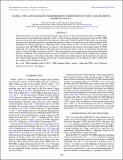GLOBAL VERY LONG BASELINE INTERFEROMETRY OBSERVATIONS OF THE 6.0 GHz HYDROXYL MASERS IN ONSALA 1
Author(s)
Fish, Vincent L.; Sjouwerman, Loránt O.
DownloadFish-2010-GLOBAL VERY LONG BAS.pdf (386.3Kb)
PUBLISHER_POLICY
Publisher Policy
Article is made available in accordance with the publisher's policy and may be subject to US copyright law. Please refer to the publisher's site for terms of use.
Terms of use
Metadata
Show full item recordAbstract
We present global very long baseline interferometry observations of the first excited-state hydroxyl (OH) masers in the massive star-forming region Onsala 1 (ON 1). The 29 masers detected are nearly all from the 6035 MHz transition and nearly all are identifiable as Zeeman pair components. The 6030 and 6035 MHz masers are coincident with previously published positions of ground-state masers to within a few milliarcseconds, and the magnetic fields deduced from Zeeman splitting are comparable. The 6.0 GHz masers in ON 1 are always found in close spatial association with 1665 MHz OH masers, in contrast to the situation in the massive star-forming region W3(OH), suggesting that extreme high density OH maser sites (excited-state masers with no accompanying ground-state maser, as seen in W3(OH)) are absent from ON 1. The large magnetic field strength among the northern, blueshifted masers is confirmed. The northern masers may trace an outflow or be associated with an exciting source separate from the other masers, or the relative velocities of the northern and southern masers may be indicative of expansion and rotation. High angular resolution observations of nonmasing material will be required in order to understand the complex maser distribution in ON 1.
Date issued
2010-06Department
Haystack ObservatoryJournal
Astrophysical Journal
Publisher
Institute of Physics/American Astronomical Society
Citation
Fish, Vincent L., and Loránt O. Sjouwerman. “GLOBAL VERY LONG BASELINE INTERFEROMETRY OBSERVATIONS OF THE 6.0 GHz HYDROXYL MASERS IN ONSALA 1.” The Astrophysical Journal 716, no. 1 (May 13, 2010): 106–113. © 2010 American Astronomical Society.
Version: Final published version
ISSN
0004-637X
1538-4357